-
Countries
-
Data and Analysis
-
Special Focus
-
Crisis Responses
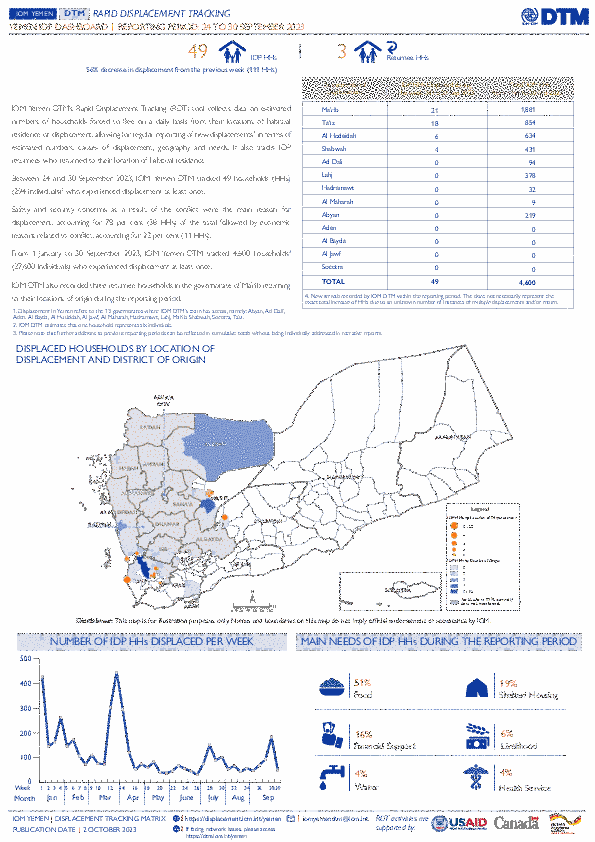
Contact
DTM Yemen, iomyemendtm@iom.int
Language
English
Location
Yemen
Period Covered
Sep 24 2023
Sep 30 2023
Activity
- Mobility Tracking
From 1 January to 30 September 2023, IOM Yemen DTM tracked 4,600 households (HH) (27,600 Individuals) who experienced displacement at least once.
Between 24 and 30 September 2023, IOM Yemen DTM tracked 49 households (294 individuals) displaced at least once. The majority of people moved into/within the following governorates and districts:
- Ma’rib (21 HHs) – Ma’rib City (18 HHs), Ma’rib (3 HHs) districts. Most displacements in the governorate originated from Al Jawf and Al Bayda.
- Ta’iz (18 HHs) – Al Makha (10 HHs), Jabal Habashi (4 HHs), Al Mudhaffar (2 HHs) districts. Most displacements in the governorate were internal.
- Al Hodeidah (6 HHs) – Al Khukhah (4 HHs), Hays (2 HHs) districts. All displacements in the governorate were internal.
The majority of people moved from the following governorates and districts:
- Ta’iz (17 HHs) – Maqbanah (12 HHs), At Ta’iziyah (2 HHs), Al Makha (1 HH) districts.
- Al Hodeidah (8 HHs) – Ad Durayhimi (3 HHs), Jabal Ras (2 HHs), At Tuhayta (1 HH) districts.
- Ma’rib (5 HHs) – Al Jubah (4 HHs), Harib (1 HH) districts.
Contact
DTM Yemen, iomyemendtm@iom.int
Location
Yemen
Activity
- Mobility Tracking
Period Covered
Sep 24 2023 -Sep 30 2023
From 1 January to 30 September 2023, IOM Yemen DTM tracked 4,600 households (HH) (27,600 Individuals) who experienced displacement at least once.
Between 24 and 30 September 2023, IOM Yemen DTM tracked 49 households (294 individuals) displaced at least once. The majority of people moved into/within the following governorates and districts:
- Ma’rib (21 HHs) – Ma’rib City (18 HHs), Ma’rib (3 HHs) districts. Most displacements in the governorate originated from Al Jawf and Al Bayda.
- Ta’iz (18 HHs) – Al Makha (10 HHs), Jabal Habashi (4 HHs), Al Mudhaffar (2 HHs) districts. Most displacements in the governorate were internal.
- Al Hodeidah (6 HHs) – Al Khukhah (4 HHs), Hays (2 HHs) districts. All displacements in the governorate were internal.
- Ta’iz (17 HHs) – Maqbanah (12 HHs), At Ta’iziyah (2 HHs), Al Makha (1 HH) districts.
- Al Hodeidah (8 HHs) – Ad Durayhimi (3 HHs), Jabal Ras (2 HHs), At Tuhayta (1 HH) districts.
- Ma’rib (5 HHs) – Al Jubah (4 HHs), Harib (1 HH) districts.
Population Groups
Survey Methodology
Unit of Analysis Or Observation
Type of Survey or Assessment
Keywords
Geographical Scope
Administrative boundaries with available data
The current dataset covers the following administrative boundaries
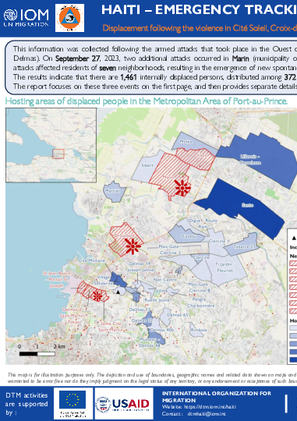
Contact
dtmhaiti@iom.int
Language
English
Location
Haiti
Period Covered
Sep 26 2023
Sep 29 2023
Activity
- Mobility Tracking
- Event Tracking
This information was collected following the armed attacks that took place in the Ouest department on September 26, 2023, specifically in the Delmas 2 neighborhood (municipality of Delmas). On September 27, 2023, two additional attacks occurred in Marin (municipality of Croix-Des-Bouquets) and the Cité Douillard neighborhood (municipality of Cité Soleil). These attacks affected residents of seven neighborhoods, resulting in the emergence of new spontaneous displacement sites. Assessments were conducted by contacting key informants via telephone. The results indicate that there are 1,461 internally displaced people, distributed among 372 households. Among them, 15 individuals are residing in one site, equivalent to three households. The report focuses on these three events on the first page, and then provides separate details for each event on the subsequent three pages.
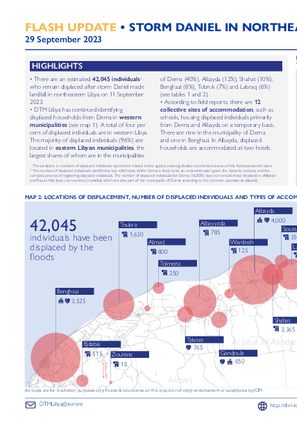
Contact
DTM Libya, DTMLibya@iom.int
Language
English
Location
Libya
Snapshot Date
Sep 29 2023
Activity
- Other
- There are an estimated 42,045 individuals who remain displaced after storm Daniel made landfall in northeastern Libya on 11 September 2023.
- DTM Libya has continued identifying displaced households from Derna in western municipalities (see map 1). A total of four per cent of displaced individuals are in western Libya. The majority of displaced individuals (96%) are located in eastern Libyan municipalities, the largest shares of whom are in the municipalities of Derna (40%), Albayda (12%), Shahat (10%), Benghazi (8%), Tobruk (7%) and Labraq (6%) (see tables 1 and 2).

Contact
DTM Sudan, DTMSudan@iom.int
Language
English
Location
Sudan
Snapshot Date
Sep 26 2023
Activity
- Mobility Tracking
- Baseline Assessment
Overview
IOM DTM Sudan is pleased to present its first Monthly Displacement Overview. This publication provides an account of Sudan’s displacement context since 15 April 2023 – outlining population caseloads and movements, as well the present and evolving needs of Sudan’s growing IDP caseload.
Rationale
Recognizing the need for more detailed insights into the IDP situation, including the priority needs, access to services, movement intentions, and demographic breakdowns of the affected population, DTM Sudan has undertaken a comprehensive review of our data collection tool. In collaboration with a wide range of internal and external stakeholders, we have developed a new tool to better inform humanitarian response operations, aligning with the DTM global methodology. Leveraging our extensive network of approximately 300 field-based enumerators and a robust system of over 1500 key informants across the country, DTM has gathered data on IDPs across 4,080 locations, in 167 of Sudan’s 189 localities – across all of Sudan’s 18 states.
Key Findings
- DTM Sudan estimates that 4,295,092 Individuals (856,578 Households) have been recently internally displaced.
- IOM DTM also reports that an estimated 1,190,633 mixed cross-border movements have been made into neighbouring countries.
- During the previous month, field teams have reported heavy clashes between RSF and SAF forces in the capital, as well as the state capitals of South Darfur and North Darfur. Additionally, inter-communal conflicts have been observed across West Darfur.
- Since 15 April 2023, 45% of the IDP caseload has sought refuge in the Darfur and Kordofan regions, whereas the majority (55%) are observed across the Northern, Eastern, and Central states.
- Just over two-thirds of the IDP caseload are seeking shelter with the host community.
- While Food Security remains the highest priority need, Health and Non-Food Items are also growing concerns.
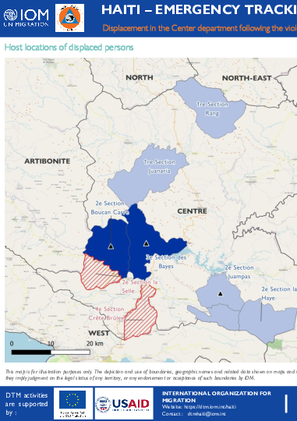
Contact
dtmhaiti@iom.int
Language
English
Location
Haiti
Period Covered
Sep 22 2023
Sep 25 2023
Activity
- Mobility Tracking
- Event Tracking
The emergency monitoring aims to gather information about significant and sudden population movements, as well as security and climate emergency situations. The information is collected through interviews with key informants and direct observation.
This information was collected following the armed attacks that occurred on September 22, 2023, in Saut D'Eau, in the 2nd communal section of La Selle, and on September 25, 2023, in Mirebalais, in the 4th communal section of Crête Brûlée, in the Center department. These attacks have affected the residents of several municipalities and have led to the creation of eight new sites. Assessments were conducted with key informants over the phone. The results indicate that 10,026 people are internally displaced persons, distributed among 3,135 households. Among them, 915 people are living in sites, corresponding to 252 households.
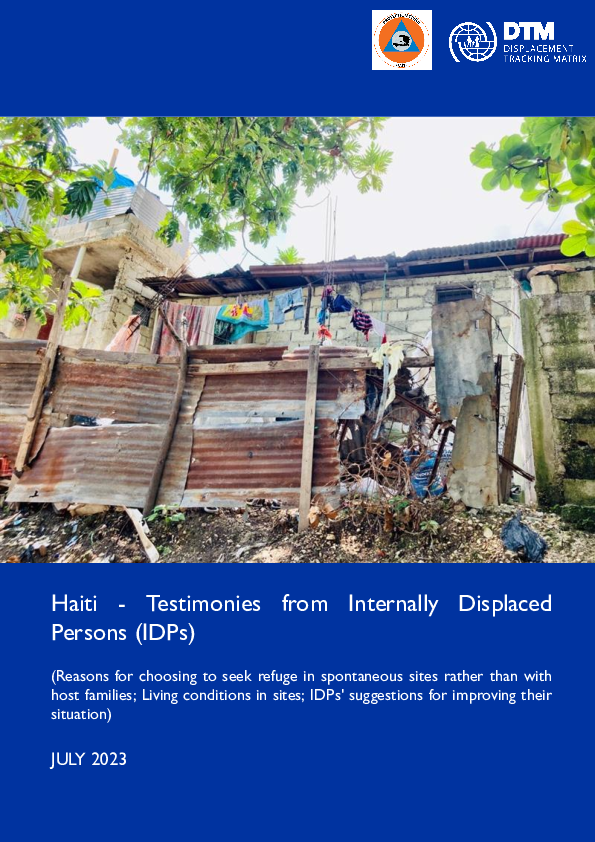
Contact
dtmhaiti@iom.int
Language
English
Location
Haiti
Period Covered
Jul 21 2023
Jul 25 2023
Activity
- Survey
- Mobility Tracking
- Site Assessment
- Baseline Assessment
This report constitutes a complementary analysis to the quantitative reports already published by DTM as part of the fourth phase of site and neighborhood assessments in the MAPAP: Information sheet on the displacement situation in the West Department, Detailed mapping of the displacement situation in the MAPAP.
The quantitative results from Round 4 have demonstrated a trend of IDPs leaving host families to settle in sites. While the total number of IDPs in the MAPAP has not significantly increased since the end of 2022 (see Map 1 and Graph 1 below), their places of accommodation have varied significantly (Graph 2). By the end of 2022, only 25 percent of IDPs were settled in sites, whereas by June 2023, this percentage had risen to 45 percent, with nearly half of the IDPs now settled in sites (Graph 2). Given that the number of IDPs has not increased significantly, these results indicate that the same IDPs previously hosted by families are moving to settle in sites where living conditions are extremely precarious, and people are exposed to higher protection risks.
This report aims to deepen the understanding of this trend through testimonies from IDPs obtained through open interviews.
Sep 27 2023
Print
Classification
International Consultant to support the development of an Environmental/Climate Migration Survey in Pakistan
Duty Station
Home-based (IOM Pakistan)
Number of positions
1
Starting Date
October 1 2023
Type
Closing Date
2023-10-09
Status
Open
Duration
4months
PROJECT AND SCOPE OF WORK
Established in 1951, IOM is the leading inter-governmental organization in the field of migration and works closely with governmental, intergovernmental and non-governmental partners. IOM is dedicated to promoting humane and orderly migration for the benefit of all. It does so by providing services and advice to governments and migrants.
The Displacement Tracking Matrix (DTM) Regional Evidence for Migration Analysis and Policy (REMAP) project was developed in response to the critical need to collect and analyze information on (protracted) displacement and human mobility in, to and from Afghanistan, Bangladesh, Kazakhstan, Kyrgyzstan, Pakistan, Tajikistan and Uzbekistan and to contribute to evidence-based humanitarian and development programming in these countries and in the region.
With the growing recognition of the complex, non-linear interplay between climate change and human mobility, IOM aims to initiate a DTM survey focused on understanding the linkages between environmental degradation/climate change and human mobility in Pakistan. This survey seeks to investigate both internal mobility within Pakistan's borders and international migration patterns of Pakistani and non-Pakistani nationals.
The primary objective of this consultancy is to design a robust methodology, including a detailed sampling plan, household survey instrument, and an overall implementation plan for the DTM environmental/climate change and human mobility survey. The consultant will play a pivotal role in shaping the framework that will guide the collection, analysis, sampling, and interpretation of data on how climate change impacts human mobility in Pakistan.
Organizational Unit / Team to which the Consultant is contributing:
The consultant will directly contribute to the DTM programme in Pakistan including DTM REMAP’s project output 1.1: Strengthened and comprehensive longitudinal disaggregated data and information management mechanism on displacement, migration, and return in Pakistan.
Under overall supervision of the DTM Programme Manager in Islamabad, Pakistan and in close coordination with the Senior Regional Project Manager (DTM REMAP) in GDI, Berlin Germany and the Senior Programme Coordinator (HRRD) in Islamabad Pakistan and the DTM Pakistan team, the consultant is responsible for developing i) Methodology Design, ii) Household Survey, iii) Implementation plan.
CATEGORY B CONSULTANTS: TASKS TO BE PERFORMED UNDER THIS CONTRACT
The consultant will undertake the following tasks:
- Methodology Design:
- Conduct a comprehensive literature review on existing research related to climate change/environmental degradation and human mobility in the context of Pakistan.
- Develop a methodological framework that outlines the overall survey design, detailed sampling strategy, data collection methods (focusing on quantitative approaches), and analytical techniques used for analysis.
- Conduct a comparative analysis and research area selection methodology of sampling areas experiencing different impacts related to environmental degradation/climate change and a detailed guideline to sample households within the selected research areas.
- Design a conceptual model that visually represents the various factors, drivers, and interactions between climate change, environmental stressors, and different forms of human mobility (internal and international).
- Household Survey Instrument:
- Design a comprehensive, longitudinal household survey instrument that captures socio-demographic information, climate-related vulnerabilities, migration histories, decision-making processes related to mobility, and perceptions of climate change impacts.
- Collaborate with local experts and stakeholders to ensure the survey instrument is culturally sensitive and contextually appropriate for Pakistan.
- Incorporate survey questions to collect quantitative data (e.g., statistical indicators) from surveyed households that explain longer-term mobility decision-making.
- Implementation Plan:
- Develop Standard Operating Procedures (SOPs) related to the selection of households and data collection efforts.
- Develop a detailed plan for the implementation of the survey, outlining timelines, roles and responsibilities, logistical considerations, and ethical guidelines.
- Propose strategies for maximizing participation and minimizing potential risks during data collection, including data privacy and security measures.
- Identify potential challenges and recommend mitigation strategies to ensure the survey’s success.
The consultant will be responsible for delivering the following:
- Methodology Document: A comprehensive document outlining the survey methodology, including the conceptual model, sampling strategy, data collection methods, and analytical techniques.
- Household Survey Instrument: A finalized version of the household survey instrument, complete with questions, response options, skip patterns, and guidelines for administration.
- Implementation Plan: A detailed plan outlining the step-by-step process of implementing the survey, including timelines, SOPs, roles, logistical considerations, and ethical safeguards.
EDUCATION, EXPERIENCE AND SKILLS
Education
- University degreein Migration studies, Political or Social Science, Business Administration, International Relations, Law or a related field from an accredited academic institution with 10 years of relevant professional experience.
Experience
- Experience in designing and implementing data collection excersises with both primary and secondary data.
- Direct experience in the design, development, and implementation of data management cycle, from planning to reporting.
- Proven experience in designing and conducting research related to climate change, migration, or displacement, preferably in the context of South Asia.
- Experience in report writing.
Skills
- Strong and demonstrable interest in human mobility, migration and displacement matters.
- Excellent writing, communication and analytical skills.
- Proven analytical skills and creative thinking.
- Excellent communication skills, efficiency, and flexibility.
- Strong analytical skills and proficiency in quantitative and qualitative research methods.
- Familiarity with the ethical considerations and challenges related to research involving vulnerable populations.
- Excellent communication and interpersonal skills, including the ability to work effectively with diverse stakeholders.
TRAVEL REQUIRED
The consultant is required to undertake at least 1 travel to Islambad, Pakistan during the consultancy.
COMPTENCIES
Values
• Inclusion and respect for diversity: respects and promotes individual and cultural differences; encourages diversity and inclusion wherever possible.
• Integrity and transparency: maintains high ethical standards and acts in a manner consistent with organizational principles/rules and standards of conduct.
• Professionalism: demonstrates ability to work in a composed, competent and committed manner and exercises careful judgment in meeting day-to-day challenges.
Core Competencies – behavioural indicators
- Teamwork: develops and promotes effective collaboration within and across units to achieve shared goals and optimize results.
- Delivering results: produces and delivers quality results in a service-oriented and timely manner; is action-oriented and committed to achieving agreed outcomes.
- Managing and sharing knowledge: continuously seeks to learn, share knowledge and innovate.
- Accountability: takes ownership for achieving the Organization’s priorities and assumes responsibility for own action and delegated work.
- Communication: encourages and contributes to clear and open communication; explains complex matters in an informative, inspiring and motivational way.
SUBMISSION OF PROPOSALS
Method of Application:
Interested candidates are invited to submit documents stated below by 09th October 2023 through e-mail to: IOMIslamabadrecruitment@iom.int mentioning the “International Consultancy for the development of a Climate Change-Human Mobility Survey in Pakistan” in subject line.
Applications should include:
- Cover letter
- Curriculum vitea
- Proposal (in English)
- Please keep the attachment size under 9 MB.
NOTE: Only shortlisted candidates will be contacted and incomplete applications or submitted in more than one file (CV+cover letter in PDF format) will not be considered

Contact
DTM Europe, DTMMediterranean@iom.int
Language
Bosnian, Croatian, Serbian
Location
Bosnia & Herzegovina
Snapshot Date
Aug 31 2023
Activity
- Flow Monitoring
Ovaj izvještaj pruža uvid u profile, iskustva, potrebe, rute putovanja i namjere migranata u tranzitu kroz Bosnu i Hercegovinu (BiH).11 Podaci su prikupljeni od 22. augusta do 1. septembra 2023. IOM je proveo vježbu praćenja ruta u Republici Srpskoj, Posavskom kantonu, Kantonu Sarajevo, Tuzlanskom kantonu, Bosansko podrinjskom kantonu i Unsko-sanskom kantonu kako bi pratio trendove ulazaka i izlazaka, kao i modalitete tranzita unutar BiH. IOM je također anketirao 411 migranata na aktivnim tranzitnim lokacijama kao što su autobuske stanice, odnosno na ključnim ulaznim i izlaznim lokacijama širom zemlje, kao i u tri tranzitna prihvatna centra u BiH (Lipa, Borići i Blažuj).

Contact
DTM Europe, DTMMediterranean@iom.int
Language
English
Location
Bosnia & Herzegovina
Snapshot Date
Aug 31 2023
Activity
- Flow Monitoring
This report provides insights into the profiles, experiences, needs, routes travelled and intentions of migrants transiting through Bosnia and Herzegovina (BiH).1 Data was collected from 22 August to 1 September 2023.
IOM carried out a route observation exercise in the Republika Srpska, Sarajevo Canton, Posavina Canton, Tuzla Canton, Bosnian-Podrinje Canton and Una Sana Canton to monitor trends in entries and exits as well as transit modalities within BiH. IOM also surveyed 411 migrants in active transit locations such as bus stops or at key entry and exit locations throughout the country as well as in three transit reception centres in BiH (Lipa, Borići and Blažuj).